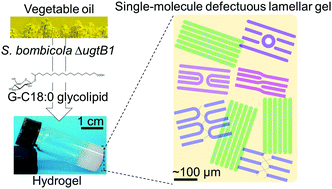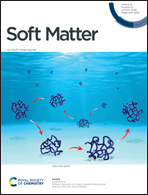Single-molecule lamellar hydrogels from bolaform microbial glucolipids†
Abstract
Lipid lamellar hydrogels are rare soft fluids composed of a phospholipid lamellar phase instead of fibrillar networks. The mechanical properties of these materials are controlled by defects, induced by local accumulation of a polymer or surfactant in a classical lipid bilayer. Herein we report a new class of lipid lamellar hydrogels composed of one single bolaform glycosylated lipid obtained by fermentation. The lipid is self-organized into flat interdigitated membranes, stabilized by electrostatic repulsive forces and stacked in micrometer-sized lamellar domains. The defects in the membranes and the interconnection of the lamellar domains are responsible, from the nano- to the micrometer scales, for the elastic properties of the hydrogels. The lamellar structure is probed by combining small angle X-ray and neutron scattering (SAXS, SANS), the defect-rich lamellar domains are visualized by polarized light microscopy while the elastic properties are studied by oscillatory rheology. The latter show that both storage G′ and loss G′′ moduli scale as a weak power-law of the frequency, that can be fitted with fractional rheology models. The hydrogels possess rheo-thinning properties with second-scale recovery. We also show that ionic strength is not only necessary, as one could expect, to control the interactions in the lamellar phase but, most importantly, it directly controls the elastic properties of the lamellar gels.



 Please wait while we load your content...
Please wait while we load your content...